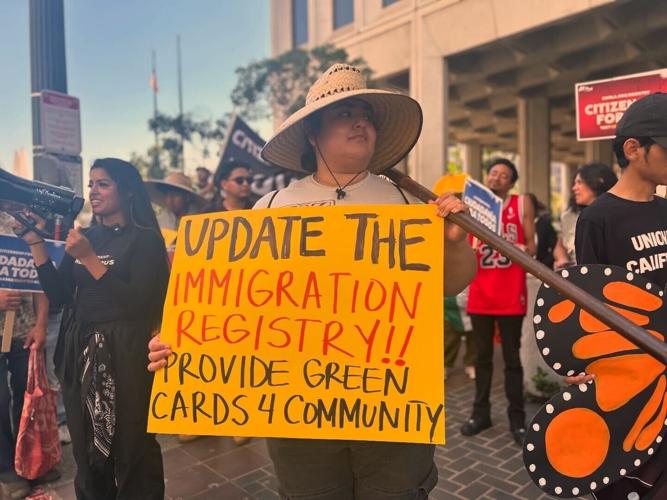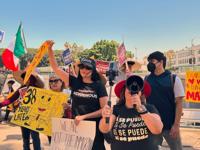
Photo by Amairani Hernadez
On Tuesday, farm workers, DACA recipients and immigration reform allies gathered together to march the streets of Los Angeles to urge Congress to pass the registry bills that will provide mass protection and a pathway to citizenship for millions of undocumented individuals.
Flor Martinez Zaragoza was one of the many people who organized the march on National Action Day, along with many farm workers who are tired of waiting for immigration reform to happen. Their only demand during the march was that the government update its registry.
Zaragoza is a 27-year-old activist and influencer known for her Instagram account, @flowerinspanish, where she currently has 258,000 followers. She is also an undocumented immigrant with DACA status and is known for her activist work with farm workers and DACA recipients.
“We are here today with farmworkers, who are eager to have their voices heard. As we know, there have been a lot of changes happening in our community, and they are the voices who are really going to help us create change,” Zaragoza said.
She also spoke about how farm workers suffer physically in the fields from pesticide exposure, saying that not only do farmworkers experience it but everyone who buys fruit in the stores does too, which is causing many cancers in the community. “It’s really important that we speak on behalf of the community on these health issues,” she said. “Let’s not forget they kept us fed during the pandemic.” Another injustice that farm workers experience is working during climate change, working in very high and hot temperatures without getting any hazard pay.
Farm workers missed a day of work to show that they are no longer scared to speak up, voice their life testimonies and march for a change in their community. Before the march started, community members were honored with a performance by Mexican folklorico dancers.
The registry is an existing immigration provision that would offer the most expensive way to open a path to citizenship for nearly eight million undocumented community members. The registry was last updated in 1986 under the Ronald Reagan Administration.
Successive measures, such as the Illegal Immigration Reform and Immigrant Responsibility Act of 1996 (IIRAIRA), stressed enforcement with no legalization safety valve. As a result, more than 20 million immigrants suffered deportation, and their families traumatized by separation Others fear the law enforcement and immigrant workers were left unprotected by a system that ignored them.
The Coalition for Humane Immigrant Rights of Los Angeles (CHIRLA) has put together a national campaign called “All in for Registry” to push Congress to update the registry to the present date. Currently, 150 organizations have endorsed the Registry Bill, which is also supported by Congressional leaders in the House and Senate. To join the fight and update the registry, click here. This will help provide a path to citizenship for immigrants who are our neighbors, friends, and family.
The registry update will also benefit those with DACA, TPS and all fully undocumented individuals who have been living in the United States for more than seven years or more.
Zaragoza and community members are asking for more allies and to call their local members to Congress and support House Bill H.R. 1511 and Senate Bill S. 2606. Zaragoza has provided a sample script for those who wish to support the cause.
“Si se puede!¡ Si se puede! ¡Si se puede! ” farm workers chanted. “Aquí estamos y no nos vamos.”

Photo by Amairani Hernandez













(0) comments
Welcome to the discussion.
Log In
Keep it Clean. Please avoid obscene, vulgar, lewd, racist or sexually-oriented language.
PLEASE TURN OFF YOUR CAPS LOCK.
Don't Threaten. Threats of harming another person will not be tolerated.
Be Truthful. Don't knowingly lie about anyone or anything.
Be Nice. No racism, sexism or any sort of -ism that is degrading to another person.
Be Proactive. Use the 'Report' link on each comment to let us know of abusive posts.
Share with Us. We'd love to hear eyewitness accounts, the history behind an article.